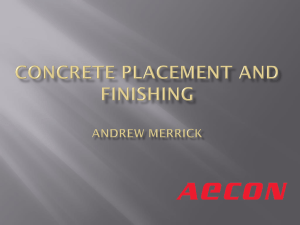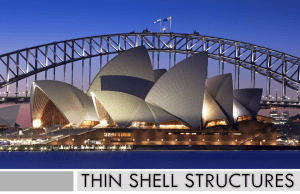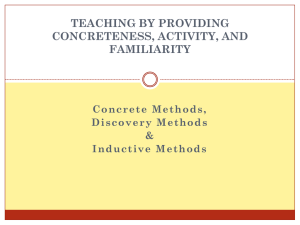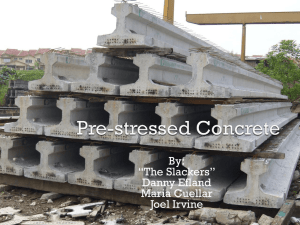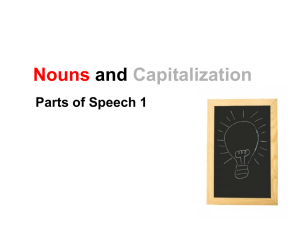CONCRETE - Stevens Institute of Technology
advertisement
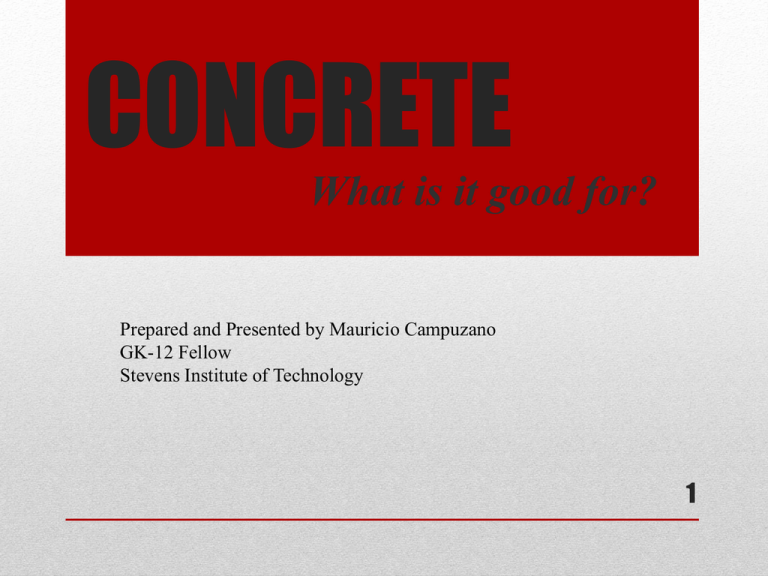
CONCRETE What is it good for? Prepared and Presented by Mauricio Campuzano GK-12 Fellow Stevens Institute of Technology 1 Concrete: “A strong, hard, building material composed of sand and gravel and cement and water” In 1824, English inventor, Joseph Aspdin invented Portland Cement H20 (l) Paste Cement Concrete Gravel/ Aggregates Admixtures What is it? Crushed Stone Calcium Silicate, 90% Corrective minerals Calcium sulfate (CaSO4) Sand 2 • Oldest known concrete found in Egyptian pyramids (~500BC) • Romans also used a form of concrete • The dome of the Pantheon is 4,535 metric tons of concrete! Ancient Concrete 3 • Additives in Opus caementicium (a.k.a Roman Concrete) • Volcanic ash allowed concrete to set under water • Horse hair made the mixture less likely to crack during hardening • Blood was added to strengthen the concrete against frost More Ancient Stuff 4 • Water and cement combine in a process called hydration, Ca3SiO5 + H2O → (CaO)·(SiO2)·(H2O)(gel) + Ca(OH)2 • “Inorganic chemical reaction where water adds to the crystal structure of a mineral, usually creating a new mineral.” • Cement paste coats & binds the aggregate; 90% cured by ~ 3 wks. • Not enough paste: • Produce rough, honeycombed surfaces and porous concrete • Too much paste: • Produce a smooth surface, but resulting concrete is likely to shrink more and be uneconomical How Does it Work? 5 • “Weight” Classification • Lightweight, < 1800 kg/m3 • Normal-weight, 2400 kg/m3 • Heavyweight, > 3200 kg/m3 • Prestressed concrete • Precast concrete • Reinforced concrete Types of Concrete 6 • Added before or during mixing of cement, water, and aggregates to enhance one or more aspects of concrete • Air-entraining: increases durability & workability • Water-reducing: more consistent setting-time • Retarding: Speed up hydration; used to counteract the accelerating effect of hot weather on concrete • Accelerating: Slow down hydration; reduce the time required for proper curing and protection, and speed up the start of finishing operations. Particularly useful in cold weather • Plasticizers: increase the workability of plastic or "fresh" concrete • Others include Pigments, Corrosion-inhibitors Admixtures 7 • Developed in the late 19th century to overcome problems of sheer stresses/strains • Concrete is strong in compression, but weak with tension • Reinforced concrete solves this problem by adding either steel reinforcing bars, steel fibers, glass fiber, or plastic fiber to carry tensile loads. Reinforced Concrete 8 Reinforced Concrete 9 • Everywhere! • “Concrete can be cast in almost any shape desired, and once hardened, can become a structural (load bearing) element.” • Used in roads, tunnels, sewers, building, etc. Where is it? 10 • LiTraCon • “light transmitting concrete,” this is a translucent concrete • Developed in 2001 by Áron Losonczi in collaboration with scientists as the technical University of Budapest • Made of fine concrete embedded with optical glass fibers Advances in Concrete 11 • Carbon Nano-fiber Reinforced Concrete • Scientists are looking to embed these fibers in concrete to strengthen concrete, limit cracks • CNFs and CNTs are amongst the strongest and stiffest materials known Advances in Concrete 12 • • • • • • • • http://en.wikipedia.org http://www.cement.org/basics http://www.fhwa.dot.gov/infrastructure/materialsgrp/ http://arch.umd.edu/Tech/Tech_III/Lectures/Concrete_Constru ction.pdf http://www.azonano.com/default.asp http://www.litracon.hu/ http://rip.trb.org/browse/dproject.asp?n=20258 http://web.mit.edu/newsoffice/2007/concrete.html References 13



